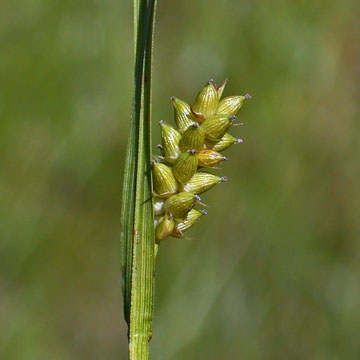

Carex conoidea - (image 1 of 3)
Taxonomy
Family: Cyperaceae
Section Griseae
Habitat
Moist open places.
Associates
Distribution
Newfoundland and Quebec to MN, south to NC and MO.
Morphology
Tufted perennial, 10-70 cm; stems usually much surpassing the leaves; main leaves 2-4 mm wide; peduncles and axis of inflorescence scabrous; terminal spike staminate, 1-2 cm, linear, long-peduncled, usually much surpassing the uppermost pistillate spike; pistillate spikes 2-4, widely separate or the upper two contiguous, short-cylindric, 1-2 cm, on short and rough peduncles; bracts foliaceous, the margins of the sheaths rough; pistillate scales ovate, much shorter than the perigynia, the midvein green and usually excurrent into a short and very rough awn; perigynia ellipsoid, 2.5-3.8 mm, beakless, with numerous impressed nerves; achene concavely trigonous.
Notes
Fruiting late May to July
Wetland indicator: FACW
An early successional species, hence the name old-field sedge. Dwarf plants that occur on gravelly shores in the northern part of its range have been called C. katahdinensis Fernald but are widely regarded as representing an ecotype rather than a distinct species.
References
Gleason, Henry A. and A. Cronquist. 1991. Manual of Vascular Plants of
Northeastern United States and Adjacent Canada. Second Ed.
The New York Botanical Garden. Bronx, NY
|
© Michael Hough 2018 |